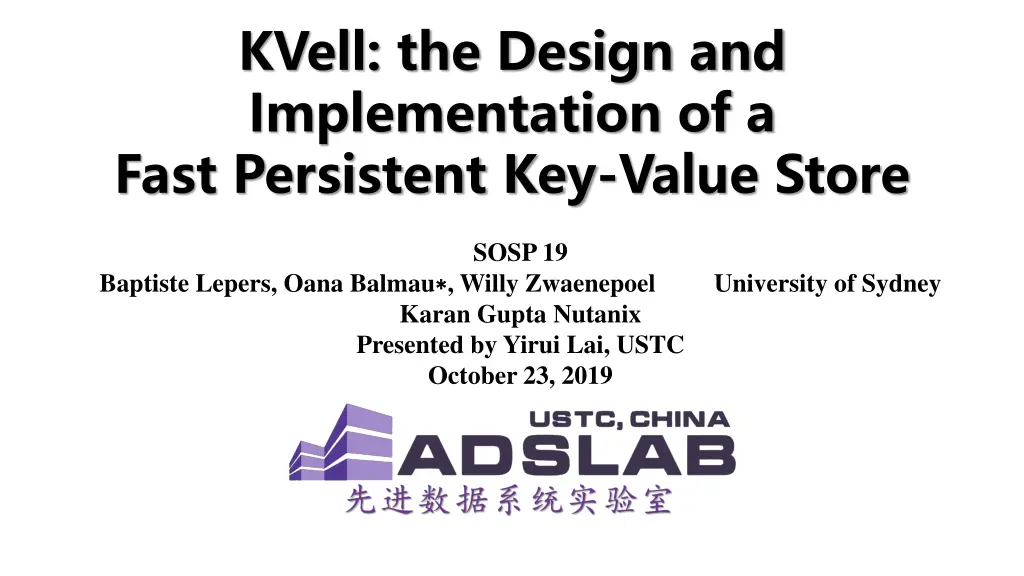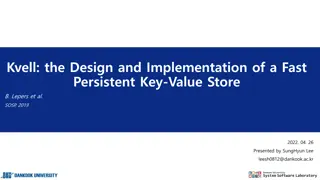
Fast Persistent Key-Value Store Design
"Explore the design and implementation of a fast persistent key-value store discussed at SOSP '19. Learn about its wide usage in various systems and the different types of memory and disk key-value operations. Delve into LSM-tree and B-tree structures, comparing their functionalities. Discover the benefits of the B+ tree structure over B-tree, offering better latency and reduced disk I/O. Join the discussion on the future of key-value stores and their significance in modern computing."
Download Presentation

Please find below an Image/Link to download the presentation.
The content on the website is provided AS IS for your information and personal use only. It may not be sold, licensed, or shared on other websites without obtaining consent from the author. If you encounter any issues during the download, it is possible that the publisher has removed the file from their server.
You are allowed to download the files provided on this website for personal or commercial use, subject to the condition that they are used lawfully. All files are the property of their respective owners.
The content on the website is provided AS IS for your information and personal use only. It may not be sold, licensed, or shared on other websites without obtaining consent from the author.
E N D
Presentation Transcript
KVell: the Design and Implementation of a Fast Persistent Key-Value Store SOSP 19 Baptiste Lepers, Oana Balmau , Willy Zwaenepoel University of Sydney Karan Gupta Nutanix Presented by Yirui Lai, USTC October 23, 2019
Outline Background Motivation Design Evaluation Conclusion 2 2 2025/8/18 ADSL
Outline Background Motivation Design Evaluation Conclusion 3 3 2025/8/18 ADSL
KV store Widely used in many systems caching (Redis) metadata management messaging (Facebook using HBase) online shopping (Facebook using RocksDB) data deduplication 3 client operations Set(k, v), Get(k), Scan(k1, k2) 2 types: Memory KV & Disk KV 8/18/2025 USTC-SYS Reading Group 4
KV store Widely used in many systems 3 client operations Set(k, v), Get(k), Scan(k1, k2) 2 types: Memory KV & Disk KV Memory KV: Redis Disk KV: LSM-tree based :LevelDB, RocksDB, PebblesDB B-tree based: WiredTiger, TokuMX Others: LSM-trie 8/18/2025 USTC-SYS Reading Group 5
LSM-tree structure Mem: 2 Memtable, mutable & immutable Disk: SSTable files 8/18/2025 USTC-SYS Reading Group 6
B-tree structure Every node(not root) can have from m/2 to m children Root has at least 2 children Data stored in internal nodes 8/18/2025 USTC-SYS Reading Group 7
B+ tree structure Store data in leaves Internal vertices only store index All request need to reach a leaf Leaves are linked for range scan 8/18/2025 USTC-SYS Reading Group 8
B+ tree structure Better than B-tree More predictable latency Fewer disk IO during read, due to smaller internal nodes 8/18/2025 USTC-SYS Reading Group 9
Outline Background Motivation Design Evaluation Conclusion 10 10 2025/8/18 ADSL
SSD disk Much more faster than traditional HDD disk Lower latency and higher throughput More useful improvement We use 3 different SSD to show this 8/18/2025 USTC-SYS Reading Group 11
SSD disk Config CPU 32core 2.4GHz Intel Xeon 72cores 2.3GHz AWS i3.metal instance MEM SSD 480GB Intel DC S3500 Year SSD 128GB 2013 Amazon- 8NVMe 8*1.9TB NVMe SSD 488GB 2016 480GB Intel Optane 905P 4core 4.2GHz Intel i7 Optane 60GB 2018 8/18/2025 USTC-SYS Reading Group 12
SSD disk Gap between read and write is smaller 8/18/2025 USTC-SYS Reading Group 13
SSD disk Gap between sequential IO and random IO is smaller 8/18/2025 USTC-SYS Reading Group 14
SSD disk As queue depth increase, both latency and bandwidth get higher So, there is a tradeoff between low latency and high bandwidth 64 depth maybe a good balance 8/18/2025 USTC-SYS Reading Group 15
SSD disk Furthermore, new SSDs do not have throughput degradation problem Optane has better performance in latency spikes 8/18/2025 USTC-SYS Reading Group 16
Old KV with new device We run RocksDB(lsm-tree) and WiredTiger(B+ tree) on config- Optane YCSB-A workload: 50%read+50%write, uniform distribution, 1KB KV pair 8/18/2025 USTC-SYS Reading Group 17
Old KV with new device Problem: Old KV cannot make full use of disk bandwidth, while CPU become system s bottleneck Why Both these two KV system need internal operation to preserve data structure 8/18/2025 USTC-SYS Reading Group 18
Why LSM-Tree perform bad 2 kinds of internal operation: flush and compaction 8/18/2025 USTC-SYS Reading Group 19
Why LSM-Tree perform bad In the experiment before, most of the CPU time is used in compaction Up to 60% of CPU time 28% merging data 15% indexing 17% calling disk IO CPU time 28 40 15 17 Merge data Indexing Disk IO Other 8/18/2025 USTC-SYS Reading Group 20
Why B-Tree perform bad 2 kinds of internal operation: checkpointing & eviction Spending too much time waiting In the experiment before, worker threads spend 47% of the total time busy waiting Only 25% of the time spent in the kernel is dedicated to read and write calls 8/18/2025 USTC-SYS Reading Group 21
What we can learn from this Keeping data sorted in disk gets fewer benefits, due to SSDs better random performance Cost of keeping data sorted in disk remains the same Synchronization between threads is costly Batching IO request is a good choice 8/18/2025 USTC-SYS Reading Group 22
Outline Background Motivation Design Evaluation Conclusion 23 23 2025/8/18 ADSL
KVell principles Share nothing Do not sort on disk, but keep indexes in memory Aim for fewer syscalls, not for sequential I/O No commit log 8/18/2025 USTC-SYS Reading Group 24
Share nothing Partition key ranges, like region in TiKV Each working thread is assigned to a region All the request in this region is handled by this thread H-N U-Z A-G O-T Worker 2 Worker 4 Worker 1 Worker 3 8/18/2025 USTC-SYS Reading Group 25
Do not sort on disk We use an in-memory B-tree in each thread to store index Because we store unordered data in disk, there is no need to move them if we don t update it All the CPU time spent on sorting can be saved B-tree Store Key-index pairs A-G Worker 1 8/18/2025 USTC-SYS Reading Group 26
Aim for fewer syscalls & No commit log As we mentioned, an appropriate queue depth is needed to achieve both low latency and high bandwidth We still batch IO request, but not for sequential IO Fewer syscalls also reduce CPU utilization Since we can store data at its final position, we just acknowledges updates after they have been persisted 8/18/2025 USTC-SYS Reading Group 27
KVell design Disk component We store KV pairs fit in the same size range in slab files KVell access slabs in block granularity, 4k in our machine For KV size<4k, update is done in place For KV size>4k, we append them to slab and put a tombstone For KV size change, we write it in new slab and delete it from the old 8/18/2025 USTC-SYS Reading Group 28
KVell design Disk component For item<2k Timestamp, size, key-value For item<4k Tombstone+info Timestamp, size, key- value(part) For item>4k Timestamp, size, key- value(next part) All information is on disk 8/18/2025 USTC-SYS Reading Group 29
KVell design Memory component B-tree Page cache Free list Worker 1 (A-G range) 8/18/2025 USTC-SYS Reading Group 30
KVell design Memory component In memory B-tree use key as index, store KV pair s disk location We use key but not hash(key) as index for scan In average, an item need 19B to store, so a 100GB database with 1KB KV pair need 1.7GB memory We also support flushing this tree to disk, but not suggest 8/18/2025 USTC-SYS Reading Group 31
KVell design Memory component Freelist is used to recycle those tombstones and provide enough blocks for an IO batch Each worker has a freelist with a constant length(64 in our config) Freelist works as a queue, every block need to be pushed into it When freelist is full, it pops the 1stblock, push the new block, and write the 1stblock s index in new block 66 65 3 Tombstone+info This info stores another free block 1 2 8/18/2025 USTC-SYS Reading Group 32
KVell design Client interface Set(k, v) Insert in worker s B-tree Write in page cache Flush cache Get(k) Search worker s B-tree Read from cache or disk Scan(k1, k2) Need a master thread to search on all workers Merge results from workers Read disk 8/18/2025 USTC-SYS Reading Group 33
KVell design Recovery Designed for failurefree situation Once crash, scan all slabs and rebuild in-mem B-tree Slow but safe All information is on disk 8/18/2025 USTC-SYS Reading Group 34
KVell design scope About 128B~4KB KV pair, not for small KV pairs Work on Optane SSD System have a sizable memory Not much scan 8/18/2025 USTC-SYS Reading Group 35
Outline Background Motivation Design Evaluation Conclusion 36 36 2025/8/18 ADSL
Experimental setting Config as before Config CPU 32core 2.4GHz Intel Xeon 72cores 2.3GHz AWS i3.metal instance MEM SSD 480GB Intel DC S3500 Year SSD 128GB 2013 Amazon- 8NVMe 8*1.9TB NVMe SSD 488GB 2016 480GB Intel Optane 905P 4core 4.2GHz Intel i7 Optane 60GB 2018 8/18/2025 USTC-SYS Reading Group 37
Experimental setting Rivals: RocksDB, PebblesDB, TokuMX, WiredTiger YCSB settings: KV pair size:1KB Numbers: 100M Total size: 100GB Memory setting: available memory<1/3 total size 8/18/2025 USTC-SYS Reading Group 38
Experiment results -Throughput On config-Optane YCSB A-F YCSB E is bad because KVell performs bad in scan A: 5.8* B, C: 2.2* & 2.7* E: slightly lower, 32% better on Zipfian 8/18/2025 USTC-SYS Reading Group 39
Experiment results Device utilization On config-Optane YCSB A, Uniform Nearly 100% disk bandwidth is used Theoretically, best performance is 500K IOPS/1.17 = 428K, while we reach 420K IOPS 8/18/2025 USTC-SYS Reading Group 40
Experiment results Throughput over time On config-Optane YCSB A,B,C,E Uniform Measured every second KVell present a steady line 8/18/2025 USTC-SYS Reading Group 41
Experiment results Tail latency On config-Optane YCSB A Uniform KVell don t suffer from tail latency because no internal operation is needed 8/18/2025 USTC-SYS Reading Group 42
Experiment results On config-8NVMe YCSB A-F Uniform In YCSB A, KVell is 6.7*, 8*, 13* and 9.3* better than rivals In YCSB E, KVell slightly better than RocksDB 8/18/2025 USTC-SYS Reading Group 43
Experiment results Real workload Real workloads, from Nutanix Inc 57:41:2 write:read:scan ratio KV size: 250B~1KB, 400B average Total dataset size: 256GB Workload 1 is uniform Workload 2 is skewed 8/18/2025 USTC-SYS Reading Group 44
Experiment results Real workload Nutanix Inc workloads On config-Optane Only 30GB mem Almost 4* better 8/18/2025 USTC-SYS Reading Group 45
Experiment results - Scalability YCSB 5TB Dataset 30GB mem Uniform Just slightly lower than 100GB test Achieve 92% of peak bandwidth 8/18/2025 USTC-SYS Reading Group 46
Experiment results - Limitations Impact of item size KVell performs steady when size changes Small item is not suitable for it 8/18/2025 USTC-SYS Reading Group 47
Experiment results - Limitations Impact of memory size KVell put index in memory Lack of memory will slow system down 8/18/2025 USTC-SYS Reading Group 48
Experiment results Recovery time Recover from failure with a 100GB database(YCSB A) on Config- Amazon-8NVMe Even though KVell need to scan all files, it still recovers faster No commit log is main reason DB KVell RocksDB WiredTiger Time/s 6.6 18 24 8/18/2025 USTC-SYS Reading Group 49
Outline Background Motivation Design Evaluation Conclusion 50 50 2025/8/18 ADSL

